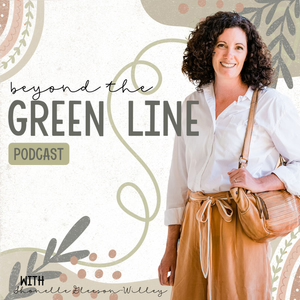
Beyond The Green Line
Moss Environmental
All episodes
Best episodes
Seasons
Top 10 Beyond The Green Line Episodes
Goodpods has curated a list of the 10 best Beyond The Green Line episodes, ranked by the number of listens and likes each episode have garnered from our listeners. If you are listening to Beyond The Green Line for the first time, there's no better place to start than with one of these standout episodes. If you are a fan of the show, vote for your favorite Beyond The Green Line episode by adding your comments to the episode page.
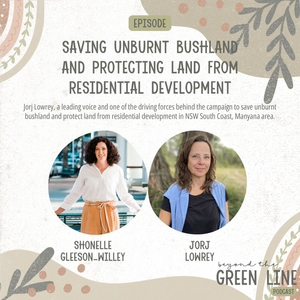
Saving Unburnt Bushland and Protecting Land From Residential Development - with Jorj Lowrey
Beyond The Green Line
04/25/22 • 43 min
On today’s episode, we talk with Jorj Lowrey from Manyana Matters, a grassroots environmental movement in New South Whales.
The community action group Manyana Matters has been fighting new residential development in their section of New South Whales, because it contains one of the only unburnt areas of bushland around the Conjola National Park. The organization has been successful in educating empowering the community of Manyana, and in bringing attention to the environmental importance of their patch of the mid south coast.
Jorj moved to Manyana after traveling around Australia in her motor home, and cherishes the area’s wildlife, beautiful coast, and peaceful scenery. The town has the beach, the bush, a lake, and great community.
Soon after she moved, a conversation with the local council revealed a development plan zoned for three parcels of land that had been dormant for about twenty years. In 2017, after living there for a short while, Jorj witnessed one of those patches - a lovely piece of coastal scrub land - quickly be developed into housing, with what seemed like very little community involvement.
After watching Kangaroos, snakes, and other wildlife become displaced and distressed from the quick build, and witnessing the rapid mulching of significant trees in the area, she mobilized by joining the local community committee.
She also created a Facebook group, Manyana Matters, and began to raise awareness and discuss the issues around the possibility of further real estate development in the other two plots of land in question.
Community understanding and engagement about the issue increased just as housing in the area was becoming more in-demand - and increasingly so when the corona virus further effected the housing market.
Then, a tragic number of fires hit the area. They swept past Manyana closely on two occasions, and people were trapped in the area - some even diving into the ocean and swimming out as far as they could to wait out the fires. Air assistance was prohibited because of the smoke, and just as several back fences began to catch on fire, a last-minute change in the wind sent the fire back on itself. Days later, power to the area was restored and the town recovered.
Now, the only unburnt patch of land in the town... was the one slated for development next. Community members began to consider it a type of ecological reserve, and are united in their desire to ensure that it’s preserved.
Jorj shares how the fires effected many species in the area, and how critical it will be to keep the unburnt section stable in the years ahead.
Now Manyana Matters is consistently engaging politicians and partnering with media outlets in meaningful and effective conversations about the area, and the importance of more careful housing development.
Jorj’s passion is contagious as she describes what began as a small community group “ripple” becoming a well-known wave. We look forward to the tsunami of change it will bring in the days ahead.
https://www.facebook.com/manyanamatters/
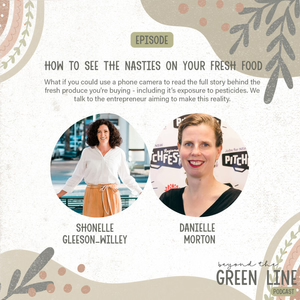
How To See The Nasties On Your Fresh Food - with Danielle Morton
Beyond The Green Line
03/21/22 • 17 min
In this episode of Beyond the Green Line, Shonelle Gleeson-Willey talks with Danielle Morton, a banking sector professional turned entrepreneur and founder of Zondii - a venture that’s using the capabilities of “blue sky” (spectroscopy) technology to identify residual herbicides and pesticides in food and fiber.
Danielle is dedicated to making more knowledge available to the public about the food we eat and the fiber we wear by implementing simple ways for producers to ensure quality - including using the selfie camera of a smartphone to guarantee their final products are safe from harmful pesticides, additives, and chemicals.
Danielle teaches us about “blue sky” technology, which used to just be used in realms like art restoration, but that can now help families that have allergies and sensitivities, as well as anyone who wants to know more about what’s in the food they purchase and clothing they buy.
Danielle’s personal experience watching how healthy, whole foods helped her children recover from gut and sleep issues led her to research the specifics of food producers’ certification processes. She eventually teamed up with a group of spectrometry scientists and spear-headed implementing it in the food and clothing industries. She now works with the creators of the technology and producers in the food industry in researching simple ways to authenticate the cleanest and healthiest food options, like ensuring a food is indeed organic.
Shonelle and Danielle discuss the process of creating a start-up company, connecting with researchers and scientists, and building project teams.
Finally, they look ahead to the impact Zondii will have when consumers’ have the ability to scan produce in the store and truly choose the best product. This includes Organic and Regenerative Agriculture produce, which often contain little to no pesticides.
(Links and socials)
Website - https://zondii.com/
Twitter - https://twitter.com/Zondii1
LinkedIn - https://www.linkedin.com/company/zondii/
Facebook - https://www.facebook.com/Zondii-2043167555978011
Instagram - https://www.instagram.com/zondiiapp
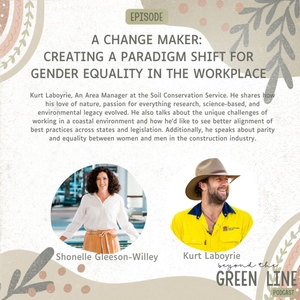
A Change Maker: Creating A Paradigm Shift For Gender Equality In The Workplace
Beyond The Green Line
08/17/22 • 49 min
Today on Beyond the Green Line, Shonelle Gleeson-Willey talks with Kurt Laboyrie, an area manager at the Soil Conservation Service. Kurt is also a past member of the International Erosion Control Association Board, and recently received a Change Makers achievement from the organization Future Women.
Kurt has always lived on the coast and spent time in nature, where he developed an understanding of how sediment and water moved. He earned his masters’ degree in Coastal Planning and Management, then began his career in erosion control in sand dunes.
He worked on dune stabilization and natural area management, fire trail and asset protection, zone construction and maintenance, creek line remediation projects, contaminated land rehabilitation, and design and construction of drainage structures. He also held advisory roles as a Certified Professional in Erosion and Sediment Control.
Kurt now manages numerous civil and environmental construction works, serving local landholders, state, federal and corporate clients. Maintaining his focus on coastal environmental management, Kurt has kept a passion for environmental legacy, always striving to contribute to lasting change.
The Soil Conservation Service is a government contractor and also deals in the public space. Kurt shares his insights on how to build good teams for highly varied jobs, and how those diverse teams enable the company to fix problems for clients and take on challenges and risks that not everyone would be willing to.
Kurt and Shonelle also chat about Kurt’s desire to see gender parity and equal pay in the construction industry. Many top companies have a measure of equality at the highest levels, while the construction industry is behind in this and has been traditionally very male-dominated. Kurt shares what a single individual in the system can do to encourage more diversity and equity in their work culture.
Kurt recounts a contaminated land rehab project that his team recently completed, which comprised of both terrestrial and aquatic rehabilitation. Older boat paint containing lead and other harmful metals was effecting a populated area’s oysters, fish and potentially humans, and it was Kurt’s job to come up with a way to get all the harmful material out of the harbor and send it to a registered site.
He talks about the importance of the staging equipment they used, how they implemented two sediment curtains into the process, why they used a dredge, and how they pumped contaminated water into dewatering bags, sealed to limit human exposure.
We’ll hear Kurt speak on the unique challenges of working in the coastal environment, and share how he’d love to see better alignment on Best Practice across states and legislations in order to see LGA’s working together for the most efficient solutions.
Learn more about Soil Conservation Service: www.scs.nsw.gov.au/
YouTube https://www.bing.com/search?q=soil+conservation+service+youtube&qs=n&form=QBRE&msbsrank=6_6__0&sp=-1&pq=soil+conservation+service+cs+youtube&sc=636&sk=&cvid=9EE4426D9FCD43B48E8BF22659F0DE1F&ghsh=0&ghacc=0&ghpl=
Facebook
https://www.facebook.com/NSWSCS/
LinkedIn.
https://www.linkedin.com/company/soil-conservation-service?original_referer=https%3A%2F%2Fwww%2Ebing%2Ecom%2F&originalSubdomain=au
More about the Gender Parity Take aways:
Understand Yourself- so you can help. Do you have unconscious Bias, do this test?
Select a Test (harvard.edu) Choose the Gender-Career IAT.
Understand the problem- https://implicit.harvard.edu/implicit/selectatest.html
The Lift- What is the gender pay gap?
https://www.bing.com/videos/search?q=the+lift+gender+youtube&&view=detail&mid=143F5413B212A71023E7143F5413B212A71023E7&&FORM=VRDGAR&ru=%2Fvideos%2Fsearch%3Fq%3Dthe%2Blift%2Bgender%2Byoutube%26qpvt%3Dthe%2Bli
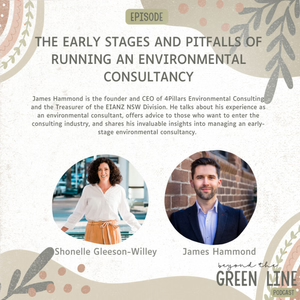
The Early Stages and Pitfalls of Running An Environmental Consultancy
Beyond The Green Line
07/26/22 • 41 min
Today on Beyond the Green Line, Shonelle Gleeson-Willey talks with James Hammond, founder and CEO of 4Pillars Environmental Consulting.
James manages a 14-person team that provides a wide range of services in environmental management and compliance, contaminated waste solutions, and impact assessment.
James has a scientific and professional background, and a love for strategic environmental management. Shonelle asks about his journey to becoming an environmental consultant, and what his advice would be to young professionals that may want to enter into the field of consulting.
Getting his business off the ground included starting in a garage office, relying on grassroots word of mouth leads, and plenty of hard work. James made a decision to avoid being a sub-contractor under another companies, because he saw the advantage of only offering services directly to clients.
James describes the importance of building a support team and knowing your limits as a business owner, as well as patience and level-headed decision-making during the grind of building a business from scratch.
He implemented software and systems that would work even after the company grew, and always attempted to envision the end from the beginning. Whether a business owner’s end goal is passive income, getting acquired, or building a family legacy company, these differing end goals will effect strategic choices in the beginning stages.
James named his company 4Pillars because it operates under the presupposition that there are four pillars to sustainable development: environment, society, economy, and intergenerational equity. The pillars must be considered altogether in order to operate in ways that are responsible for tomorrow.
Shonelle and James discuss how some of 4Pillar’s current impact assessment projects are gathering their data and developing strategies for their clients. James shares that within cities, air, noise and water are usually the three focuses, whereas in more remote areas there are different priorities.
They reference the ongoing issue of asbestos contamination in soil, and the hope that policy consistency across different agencies and levels of government will move this important work in the right direction.
He talks about the times his assessments have resulted in avoidance recommendations, and how to present those types of recommendations effectively.
Volunteer work is often a part of the most effective environmental scientists and consultants, and James shares about his enthusiastic involvement with the Environmental Institute of Australia and New Zealand.
Today’s conversation also touches on the topic of green accounting and how it’s effecting the environmental consulting field.
This helpful interview with James Hammond is sure to be a source of inspiration for a lot of listeners, especially those who are starting out in the environmental consulting space.
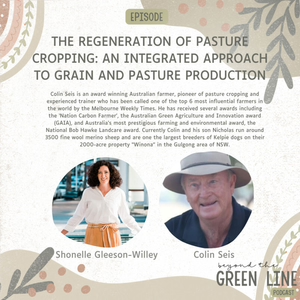
The Regeneration of Pasture Cropping: An Integrated Approach To Grain And Pasture Production
Beyond The Green Line
08/11/22 • 33 min
On today’s episode of Beyond the Green Line, Shonelle Gleeson-Willey talks with the inventor of pasture cropping: Colin Seis.
Colin oversees 3,500 Merino sheep on his property in the Central Tablelands of New South Wales, where he also grows cereal crops and natives grasses. He and his son, Nick, breed Kelpie dogs on the land as well.
Collin has received a Conservation Farmer of the Year Award, Australian Carbon Farmer of the Year, NSW Regional Achievement and Community Award, and was recently called one of the top 6 most influential farmers in the world by the Melbourne Weekly Times.
His 2,000 acre plot is called Winona, and it has a widespread reputation for holding up amazingly during drought. Its predominant soils include coarse and fine sands derived from granite, which are not considered highly fertile, but he shares with us how pasture cropping is a way of working alongside nature instead of against it, resulting in a more robust and resilient farm.
Colin describes pasture cropping as the way that crops were originally cultivated in ancient times: not by killing every other plant in the area, but by sewing crops in with native grasses and other plants, so that competing roots can improve a crop’s vitality, water retention and wind protection.
Colin developed the approach of pasture cropping along with a neighbor farmer after a devastating bush fire in 1979. Today, the land can now officially be called restored grassland, and Colin can be found teaching his regenerative methods to farmers around the world through his online “Smart Soil” classes.
Collin’s sheep are also managed holistically, using a method he describes as time-controlled grazing.
He educates us that gross margin (profit) is greater in a pasture cropping, because multiple products are being harvested. The crops are about the same yield, just slightly more variable. But native grass seed is harvested in addition, increasing profits.
Fertilizer is still used on Winona, but has been reduced over time as sheep grazing increasingly becomes a type of natural mulching and fertilizing.
Collin recounts that in the early years, he was ostracized by the industry for attempting to sell combined crops, and had to have self-belief and confidence to continue. He notes that his first supporters were ecologists, because they had understanding of diverse systems.
He discloses that one of the biggest advantages of pasture cropping is the stimulation and germination of dormant seed - even seed that has been sitting for decades. This can be a significant factor in restoring grasslands.
Soil carbon levels have increased over time at Colin’s farm, and current measurements are detecting increased carbon as far down as a meter. Colin shares that this is due to plant diversification, and bigger perennial plants with deeper roots.
We know you’ll be encouraged to hear from one of the legends in regenerative agriculture on this episode.
Check out Colin’s family land:
www.Winona.net.au
And take a look at his classes:
www.SmartSoilEdu.com
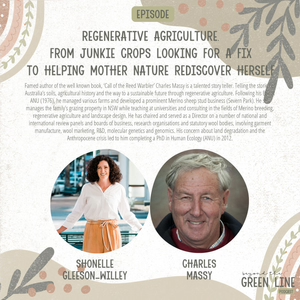
Regenerative Agriculture – From Junkie Crops Looking For A Fix To Helping Mother Nature Rediscover Herself
Beyond The Green Line
07/12/22 • 56 min
Today on Beyond the Green Line, Shonelle Gleeson-Willey talks with regenerative agriculturist Dr. Charles Massy.
Charles became an advocate for regenerative agriculture after the infamous four-year draught of the late 70’s and early 80’s, when he transformed his personal approach from conventional farming to regenerative holistic management of his property on the Monaro.
He has now written three books, received an OAM, and maintained a chemical-free property for decades - one that boasts native grass in an area where surrounding farms have turned to dustbowls during recent droughts.
We hear all about his life-altering decision to transition to regenerative farming, the keys to his success in the process of restoring his soil, and his PhD research on some of the catalysts and destabilizing events that cause regenerative farmers begin to adopt the approach and turn their landscapes around.
Shonelle and Charles discuss the crucial topic of fertilizer, and how natural alternatives to chemical herbicides and pesticides - like worm juice and compost extract - can result in better nutrition and healthier soil.
Dr. Charles Massy defines regenerative agriculture succinctly by saying, “it’s working with biology and not against it.” He clarifies that every farmer’s biggest asset is the land, even above their animals or crops, and reminds us all that there is indeed a way to successfully utilize natural soil and graze animals in a sustainable and healthy way.
He asserts that nature’s self-organizing processes are far superior to our simplified, chemical-driven modern approach. By maximizing solar energy, protecting soil health, tending to the water cycle, ensuring biodiversity, and refraining from interfering nature’s timing, humans can become better stewards of land while harvesting more nutritious crops.
Charles explains that during the scientific revolution, humanity shifted to a “mechanical mind,” and distanced ourselves from nature. The combination of that more arrogant mindset with the invention of chemical fertilizers, big farming machinery, and motive for profit after World War II is what created the modern human ecosystem of farming in the form it exists today.
But, now that we’re more aware than ever of our climate and soil’s vulnerable state, a swing back to regenerative agriculture would have a huge positive impact on the planet as well as human health. Charles skillfully teaches us about the biology and carbon impact of different approaches to farming, and casts vision from where we can, and must, go from here.

How This Female Entrepreneur Turned Used Tyres Into Decor Treasures
Beyond The Green Line
07/21/22 • 26 min
Today’s episode of Beyond the Green Line is hosted by one of our key consultants, Elizabeth Ogunsote. Elizabeth hosts a fascinating conversation about upcycling with entrepreneur Olabanke Subair, the accomplished owner and creative director of sustainable home decor company Cyrus45.
Cyrus45 upcycles non-biodegradable waste such as used tires in Lagos, Nigeria, turning them into artistic modern furniture. They won the 2018 ACE award for the Best Eco-friendly Product.
Today we hear what inspired Olabanke to build her company, what went in to starting her factory, and how she stays creatively inspired, 5 years in.
She explains how she resources used tires in Nigeria now that the business has grown, and shares a philosophical and inspiring commentary on what constitutes true creativity, and we can all tap into it as we reduce each of our own carbon footprints. We learn how problem-solving, innovation, and creativity interplay in Olabanke’s leadership style, and what’s coming next for one of her other businesses, Doodle Arts.
Elizabeth asks Olabanke about tire fires, and we hear how we can prevent raging land-fill fires and slow down the disposing of tires in those locations. Olabanke also shares about production, language and environmental challenges that the factory has faced, and how even that has prompted her to think about new designs.
Having created a handful of artistic start-ups as an “ecopreneur” and creative disruptor, Olabanke shares why Cyrus45 is her most meaningful accomplishment to date, and why she feels proud of where it’s heading in the future. She shares words of wisdom to future entrepreneurs about how to balance their creativity with patience and perseverance in order to survive the tedious ride.
Cyrus45 factory’s gloss-painted tires form the foundations for beautiful rocking chairs, classy glass end tables, and circular wall mirrors, so we encourage you to click on the links below and follow their amazing journey as a sustainable furniture store.
Follow Olabanke:
https://www.instagram.com/doodlegraphie/
Follow Olabanke’s company:
https://www.facebook.com/cyrus45factory/
https://twitter.com/cyrus45factory
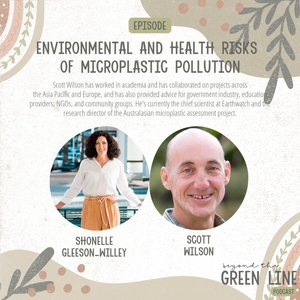
Environmental And Health Risks Of Microplastic Pollution
Beyond The Green Line
06/13/22 • 39 min
In this episode of Beyond the Green Line, Shonelle Gleeson-Willey talks with Dr Scott Wilson Chief Scientist at Earthwatch Institute Australia and the Research Director of the Australasian Microplastic Assessment Project. He's also an Honorary Senior Research Fellow in the Department of Earth as well as Environmental Sciences at Macquarie University.
In his role as Research Director for the Australasian Microplastic Assessment Project (AUSMAP), the Eureka Prize-winning citizen science initiative that researches microplastic pollution hotspots and its sources, he collaborates closely with stakeholders on finding practical solutions to microplastic pollution across Asia Pacific and Europe.
Scott has always wanted to make an impact on the environment and in his new role at Earthwatch Institute Australia, he now has a broader opportunity for more engagement and impact not only in Australia but globally.
His current focus is understanding the causes and impacts of plastics on the environment while collaborating with stakeholders and the community across the country.
In this episode, Scott addresses the need for educating and raising public awareness about a variety of environmental concerns, as well as a number of programs offered by Earthwatch Institute Australia for local communities to get involved in.
He also discusses his involvement in several other environmental projects, including the ClimateWatch program, a community-based venture aimed at documenting seasonal changes like plant flowering and seasonal animal migrations and educating communities on how these trends are affected by changing climate patterns.
Scott also discusses Earthwatch’s new Tiny Forest program, which uses Miyawaki Japanese botany to boost biodiversity through the dense planting of endemic vegetation in urban areas.
Scott also talks more about his work with the AUSMAP program dedicated to researching the environmental repercussions and the eradication of ‘per-and polyfluoroalkyl substances’ (PFAS) contaminants in the environment, and also his work with the Australian non-profit environmental organisation the Total Environment Centre, and its partnerships between universities and local communities.
Scott highlights recent studies on the increasing amounts of microplastics and other contaminants in the atmosphere, and also speaks in detail about how both positive and negative trends in exponential plastic manufacturing and use will affect the environment and particularly the ocean over the next thirty years.
Finally, Scott discusses his work with the Australian non-profit environmental organisation, the Total Environment Centre, and its partnerships between universities and local communities.
Thanks to Dr Scott Wilson for this important conversation. Please visit the Earthwatch website www.earthwatch.org.au for more information on its various projects and to find out how you can also play your part in helping the environment and making a difference in the world.
This episode of Beyond The Green Line was brought to you by Moss Environmental.
Subscribe to our podcast for your weekly invitation to join the conversation.
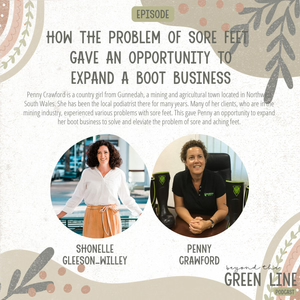
How The Problem Of Sore Feet Gave An Opportunity to Expand A Boot Business
Beyond The Green Line
07/04/22 • 25 min
On today’s episode of Beyond the Green Line, Shonelle interviews former podiatrist turned work boot designer Penny Crawford.
Penny is a country girl from Gunnedah, a small town in the Liverpool planes of NSW that’s made up of farmland, mines, the Namoi river, and copious Koalas.
Many miners visited her practice complaining of sore feet from their work, and her care for her patients has propelled her to create her company, Crawford Boots. Her incredibly helpful invention - a waterproof safety work book that actually fits correctly - withstood rigorous on-site survey research and gained raving reviews from grateful miners.
Penny shares that most of her patients’ foot issues were caused by ill-fitting footwear, and her desire to see the problem solved at the source let her to design and manufacture unique work boots that utilized two factories: one that specialized in the outer casing of the water proof boot, and one that designed superior in-soles.
We hear all about her boot company’s big wins, supply chain challenges, and new partnership with the University of New South Wales’ Sustainable Research and Technology Center in a circular economy-inspired rubber recycling project, using her brand’s boots.
From the get-go, Penny desired to use sustainable materials (like rubber instead of PVC), and had in mind the end goal of creating a product that could be part of the circular economy. Then, the additional supply chain strain of Covid added another incentive to move the manufacturing process to a more local scenario.
Penny joined the AMGC (the Advanced Manufacturing Growth Centre), who assisted her in getting the boots tested to see if she could begin to replace the rubber she was using with recycled or repurposed material.
In addition, her boots’ end-of-life will now include repurposing into the steel-making industry by being combined with coal as the energy source at specific steel-making plants. Partnering with specific mining sites to provide receptacles for finished boots will ensure they collected for repurposing.
Penny won Business New South Wales’ Outstanding Business Leader, and Business of the Year 2021 for her entrepreneurship and innovative work on her boot product. We’re inspired by her work ethic and on-going commitment to responsible and sustainable business.
Take a moment to check out Dr. Penny Crawfords durable work boots:
crawfordboots.com.au
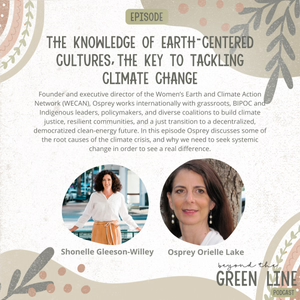
The Knowledge of Earth-Centered Cultures, the Key to Tackling Climate Change
Beyond The Green Line
07/08/24 • 42 min
Today on Beyond The Green Line, Shonelle Gleeson-Willey talks with Osprey Orielle Lake.
Founder and executive director of the Women’s Earth and Climate Action Network (WECAN), Osprey works internationally with grassroots, BIPOC and Indigenous leaders, policymakers, and diverse coalitions to build climate justice, resilient communities, and a just transition to a decentralized, democratized clean-energy future.
She sits on the executive committee for the Global Alliance for the Rights of Nature and on the steering committee for the Fossil Fuel Non-Proliferation Treaty. Osprey’s writing about climate justice, relationships with nature, women in leadership, and other topics has been featured in The Guardian, Earth Island Journal, The Ecologist, Ms. Magazine and many other publications.
In this episode Osprey shares her experience in advocating for change alongside diverse communities. She discusses some of the root causes of the climate crisis, and why we need to seek systemic change in order to see a real difference.
You’ll hear about the pivotal role women play in decreasing carbon emissions and bringing about lasting change, as well as the importance of indigenous rights and how earth centred cultures may hold the key to healing ecosystems and living harmoniously with the land.
Learn more about Osprey and read her latest book ‘The Story Is In Our Bones: How Worldviews And Climate Justice Can Remake A World In Crisis’ at https://ospreyoriellelake.earth/
Show more best episodes

Show more best episodes
FAQ
How many episodes does Beyond The Green Line have?
Beyond The Green Line currently has 25 episodes available.
What topics does Beyond The Green Line cover?
The podcast is about Conservation, Environmental, Earth Sciences, Nature, Podcasts, Green and Science.
What is the most popular episode on Beyond The Green Line?
The episode title 'Helping Communities Maintain a Voice During the Renewable Energy Boom with Warwick Giblin' is the most popular.
What is the average episode length on Beyond The Green Line?
The average episode length on Beyond The Green Line is 33 minutes.
How often are episodes of Beyond The Green Line released?
Episodes of Beyond The Green Line are typically released every 7 days, 1 hour.
When was the first episode of Beyond The Green Line?
The first episode of Beyond The Green Line was released on Mar 7, 2022.
Show more FAQ

Show more FAQ